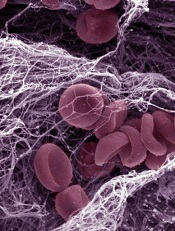
Credit: Kevin MacKenzie
The activity of transglutaminase factor XIII is critical for retaining red blood cells in a thrombus and therefore affects the clot’s size, investigators have reported in the Journal of Clinical Investigation.
The team showed that mice deficient in factor XIII had smaller thrombi containing fewer red blood cells than wild-type mice. And the same phenomenon occurred in humans.
According to the researchers, this discovery could aid the development of a safer alternative to anticoagulants.
“If we can develop a treatment that exploits this discovery to reduce the size of blood clots, it would represent a whole new approach to treating thrombosis that’s different from anything else on the market,” said study author Alisa Wolberg, PhD, of the University of North Carolina at Chapel Hill.
“We think reducing factor XIII activity could be helpful to a large number of people, perhaps including some who cannot take existing blood-thinning medications.”
Dr Wolberg and her colleagues examined the role of factor XIII in clot formation, first in mice and then in human samples. To their surprise, the team found that mice incapable of producing factor XIII formed thrombi that were half the size of the clots produced by wild-type mice.
“That difference in itself was extremely striking,” said study author Maria Aleman, PhD, also of the University of North Carolina at Chapel Hill.
“Then, the second surprise was discovering that the size difference was actually due to a reduced number of red blood cells in the clot. Since no previous studies had suggested that it was possible to manipulate the number of red blood cells, we knew we had found something new.”
Factor XIII appears to play a crucial role in helping the fibrin matrix keep its integrity during thrombus formation. Normally, the fibrin matrix forms a strong mesh in and around the clot, trapping red blood cells within. Without factor XIII, some red blood cells are squeezed out, resulting in a much smaller clot.
Unlike existing drugs that reduce the formation of fibrin, a drug that reduces factor XIII could potentially cut the body’s ability to produce large, dangerous thrombi without sacrificing the ability to produce small, beneficial clots.
“What’s needed is a drug that reduces the risk of forming large clots but still allows you to form a clot when you need one to stanch bleeding,” Dr Wolberg said. “The biological pathway we’ve discovered may make it possible to strike that balance.”

